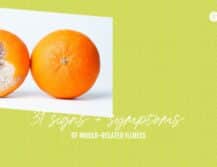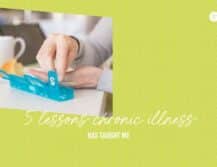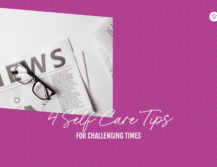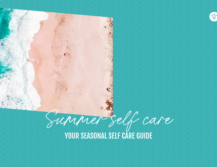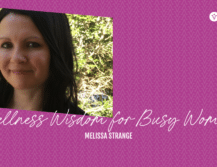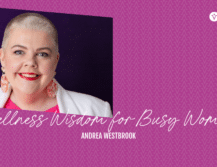
I’m sitting here in a café. I’ve brought my own cushion to use as a backrest and a heat pack because lower back pain is a needy beast. Chronic pain demands unwavering attention, which I’ve given it for nearly two weeks. I’ve tended to it with physiotherapy, remedial massage, floatation, hot AND cold treatment, pain killers, essential oils, gentle stretching and rest. So much rest.
I haven’t been to the gym. I haven’t taught a single yoga or Pilates class. In fact, I’ve barely left the house. So I’ve had ample time to think.
About?
Pain, of course.
Pain is the pits. But, as someone who has experienced both acute and chronic pain, it’s taught me a lot over the years.
For ease, I’ve distilled my learnings about chronic pain into five key points:
1. I am stronger than I think
I don’t want to glorify pain but I find it strangely fascinating just how much pain the body and mind can tolerate.
Like the time a snowboarder dislocated my shoulder as he sailed past. I can only guess that cold and shock numbed the pain as I waited (for what seemed like hours) for paramedics. My shoulder was then secured and I was strapped to a sled and towed down a bumpy, windy mountain. Ouch!
Or the time a doctor and nurse played a nauseating game of tug of war with my right arm to traction the limb and move the broken bones into correct alignment. Despite ample pain meds, the experience is seared in my brain.
And then there’s the migraines that plagued me throughout high school, university and the initial years of my career. With two or three migraines a week, I soldiered on, forcing myself to study and sit exams while enduring skull-crushing pain, visual disturbances, light sensitivity and nausea.
I endured it all. And then some. And I’m here to tell the tale, stronger and even more resilient not in spite of these experiences but because of them.
Perhaps you’ve been through something much more traumatic or more, objectively, painful, Childbirth, for instance. Mothers, I take my hat off to you.
But pain isn’t a competition and, although pain tolerance varies, I bet you’ve discovered that you’re able to bear more pain than you thought you could because you, my friend, are stronger than you think.
2. Pain is not static
When it comes to my ability to deal with and respond to pain, my experience can be divided neatly into Before Yoga and After Yoga.
Before Yoga, pain was a static or fixed experience. I was either in pain or I wasn’t. This black and white mindset saw pain as an inconvenience and something to be endured and fixed ASAP.
After Yoga, I still want the pain to go away. I’m not a masochist. I’m also fully aware you can’t mend a broken arm with meditation. But I’ve learned it can make it easier to deal with pain and the inevitable frustration.
Yoga and meditation are tools for cultivating awareness, autonomy and the ability to make skilful choices. Yoga and meditation have taught me that pain is highly nuanced and it fluctuates.
Let me show you.
Sit comfortably, with your eyes open or closed.
Starting at the crown of your head, slowly scan down, observing the physical sensations. What do you feel? Notice where you are holding on or areas where there is tension, tightness or discomfort. Let your awareness settle on an area of pain or discomfort. If there is more than one area, identify the most prominent sensation.
Start by simply being with the sensation. When pain or discomfort is present, it exerts a strong pull on your attention, to the extent that it can be difficult to focus on anything else. At first, it may grow in intensity… or at least seem to because you are focused on it. Don’t try to escape or deny or numb it. Just sit and observe. Locate the centre of the sensation, investigate, taking note of its shape, intensity, texture and temperature. Notice how the sensation actually shifts and changes. What seemed static is anything but.
It’s mind-blowing, right!?
Getting to know my body – where it is in space, how it feels in any given moment, what physical (or mental) limitations are present – means I am better able to respond to its guidance. I am kinder, more compassionate towards myself, less likely to push through physical pain and, most importantly, I can sit with the emotional discomfort that arises when I’m unable to do move freely (or at all).
Right now, for example, my mobility is hampered by my back pain. It’s frustrating. I want to go to the gym. I want to teach. I want everything to just be ‘normal’.
And it will be because yoga and meditation have taught me that every experience is temporary and resistance only impedes the healing process.
So I rest. I rest and trust that the pain will subside and eventually, I’ll be able to do all the things I need and want to do. And, if for some reason, that doesn’t happen, I already have the tools to manage my mindset and reactions.
Yoga and meditation have also gifted me practical tools, including:
- poses to help stretch and alleviate tension caused by compensation patterns
- poses to strengthen areas of weakness and as a way to help reduce pain and prevent a recurrence
- breathing techniques to soothe the nervous system and calm the mind.
3. It takes a village to heal
Why settle for one modality when you can recruit a whole team of professionals from allopathic and complementary medicine backgrounds? Don’t just search for the closest practitoner, ask around to find professionals who:
- are passionate (and super nerdy) about what they do
- are committed to developing and sharing their skills and expertise
- have a strong professional network
- are willing to go the extra mile
- are compassionate
- genuinely listen, taking your needs and preferences into account when creating a treatment plan.
We’ve curated a directory of tried-and-tested wellness practitioners and facilities.
Most importantly, seek out professionals who have a loose attachment to being right, people who are willing to admit when they are stumped!
I worked with my osteopath on and off for years to manage ongoing sacro-illiac joint pain when, one day, she admitted that she had exhausted all treatment options and wanted to referred me to another practitioner, a pelvic health physiotherapist who worked with me to achieve freedom from chronic pain and life-changing mental breakthroughs.
And, don’t discount what energy healers can do to accelerate healing and explore the metaphysical aspects of pain.
4. Pain isn’t just physical
This has been a massive point of learning for me. But it took a long time to wrap my head around the idea that pain can persist long after the source of pain has disappeared.
For more than 2 years, sacro-illiac pain would come and go. The pain was searing and unpredictable. Just when I thought I had it figured out, it would morph. Sometimes it was on the right side, sometimes the left. Sometimes it travelled down to the hamstring and knee. Other times it was a more localised sensation. But I managed it. Or so I thought.
What I actually did was avoid the things that triggered pain. I was convinced yoga was the problem so I stopped going to group classes or doing yoga at home. I learned how to teach verbally so I didn’t have to demonstrate poses. The more I avoided asana (the physical poses), the greater the fear. I got to the point where yoga triggered feelings of anxiety and depression. I remember sitting at the back of the room, crying during an advanced yoga teacher training module and considered walking away.
In the absence of yoga, I went to Pilates, spin classes and started strength training.
With the help of my physio (see point #3), I was able to examine my cautious relationship to yoga and unravel my fearful thoughts. She helped me recognise that:
- the source of physical pain no longer existed
- my body is strong and capable – on and off the yoga mat
- pain isn’t solely a physical experience
- I have a choice about how I relate to and experience pain.
5. Pain is a messenger
Please don’t misunderstand. I don’t think anyone deserves pain but I do believe that, if you are willing to listen, pain can teach us valuable lessons.
There is a crack in everything. That’s how the light gets in. – Leonard Cohen
I broke my arm at a really low point in my life. I was halfway through yoga teacher training and I felt broken. That sounds dramatic but it’s how I felt at the time. It was the second bone I’d broken in six months, my support network was ripped out from underneath me and my plans to transition to a career more aligned with my values was put on hold. Unemployed, I wasn’t contributing financially to our household and, having injured my dominant arm, I couldn’t even support Sam in the role of Domestic Goddess.
I fell into a quagmire of guilt, fear, loneliness and unworthiness. My internal landscape frightened me so I looked externally for help, connecting with insightful and intuitive healers such as my kinesiologist Jo. She took one look at my broken arm, smiled and asked if I was telling people I was “on a career break”. Close but no cigar.
I hadn’t said I was on a break but I had repeatedly said – seriously and in jest – “I am broken” and “maybe I’m too broken to be a yoga teacher”.
It took us months to dismantle this mindset, to see that while I may be flawed, I am not broken. With hindsight, I can see that breaking my arm wasn’t an accident or an inconvenience, it was a blessing; it made me who I am today.
I was cracked open so the light could get in.
If you’re interested in learning more about the metaphysics of pain, check out the work of Louise Hay on the link between emotional and physical pain.
What are your aches and pains costing you?
Your health is priceless and you deserve to feel amazing! Find out how you can get back to doing what you love sooner with The Reset & Recovery Plan. Book a free call to find out if The Reset & Recovery Plan is right for you.
– Georgina –
